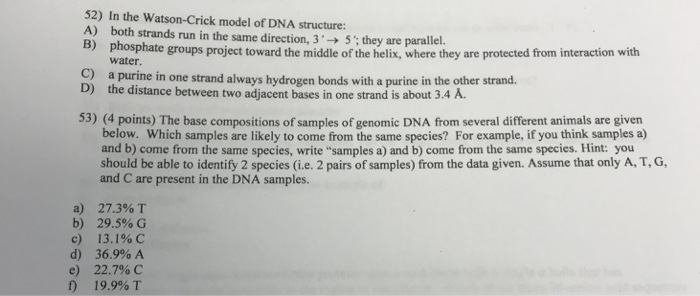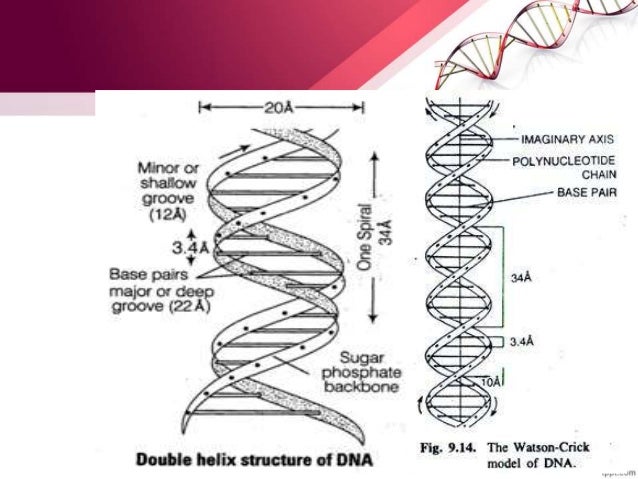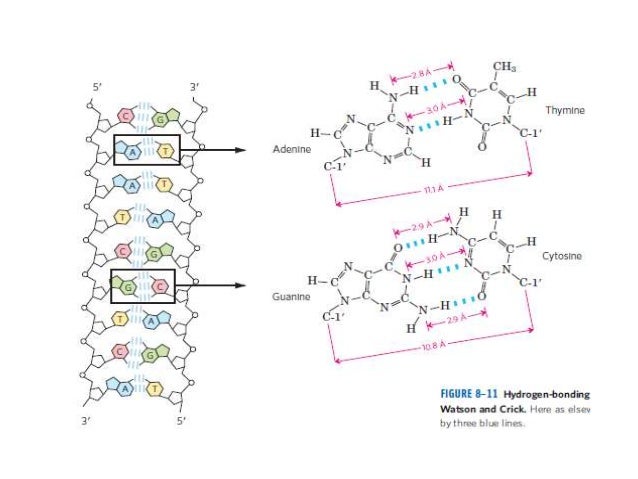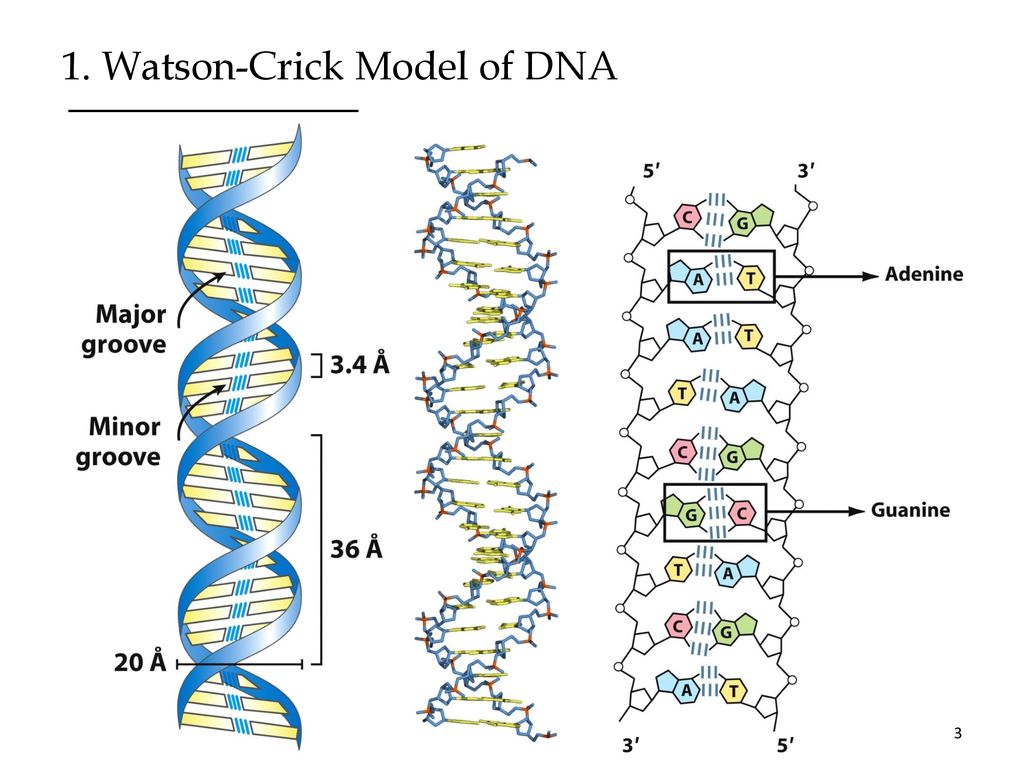The WatsonCrick model of DNA structure Watson & Crick constructed a model of DNA structure that fits Franklin's Xray diffraction data & Chargaff's rules The basic unit of nucleic acid structure is the nucleotide a 5carbon sugar molecule called ribose covalently linked to a nitrogenous base at the 1' carbon, and a phosphate at theDNA Structure Activity Problem 10 Features of the WatsonCrick Model for DNA structure Which of the following is correct about the WatsonCrick model of DNA?Structure has novel features which are ofconsiderable biological interest A structure for nucleic acid has already been proposed by Pauling and Corey' They kindly made their manuscript available to us in advance of publication Their model consists of three inter twined chains, with the phosphates near the fibre axis, and the bases on the outside In our opinion, this structure is

Dna Structure Watson Crick Franklin And Wilkins Youtube
Watson crick model of dna structure
Watson crick model of dna structure-Although the globally accepted structure is known as the Watson and Crick model of DNA structure, one important person left out of the historical teaching of DNA's discovery is Rosalind Franklin The data of this female British biophysicist was critical to Watson, Crick and Wilson's work, which would earn them a Nobel Prize for the discovery Franklin was not eligible for theThe WatsonCrick Model of DNA Structure STUDY Flashcards Learn Write Spell Test PLAY Match Gravity Created by meckels001 Terms in this set (5) The Model a)Hydrogen bonds hold complementary base pairs together in DNA b)Two DNA strands form a double helix c) Four turns of a DNA double helix double helix ladderlike structure that's twisted Antiparallel two strands in a DNA




Watson And Crick S Model Of Double Helix Of Dna Biochemistry
Watson and Crick used many aluminium templates like this one, which is the single base Adenine (A), to build a physical model of DNA in 1953 When Watson and Crick produced their double helix model of DNA, it was known that most of the specialized features of the many different life forms on Earth are made possible by proteinsDNA's Structure The model of DNA that they proposed look like none before, consisting of a doublehelix structure very similar to an extension ladder · Watson and Crick DNA Model DNA Model The threedimensional structure of DNA, first proposed by James D Watson and Francis H C Crick in 1953, The Nitrogen Bases or Nucleotides DNA strands are composed of monomers called nucleotides These monomers are often Deoxyribose Sugar Deoxyribose,
#structure of dna#watson & crick's model#nucleoside#nucleotide#nucleic acid#adinine#guanine#thymine#cytosine#purine#pyramidine#deoxy ribose · In 1953, JD Watson (an American biologist) and FHC Crick (a British Physicist) proposed the threedimensional model of physiological DNA (i e BDNA) on the basis of Xray diffraction data of DNA obtained by Franklin and Wilkins For this epochmaking discovery, Watson, Crick and Wilkins got Nobel Prize in medicine in 1962A model of DNA structure in which the molecule is a crosslinked doublestranded helix, each strand is composed of alternating links of phosphate and deoxyribose, and the strands are crosslinked by pairs of purine and pyrimidine bases projecting inward from the deoxyribose sugars and joined by hydrogen bonds with adenine paired with thymine and with cytosine paired with
Phobeus Levene proposed the Tetra nucleotide theory and Linus Pauling's triple helix model Both these even though wrong provided many clues regarding the DNA structure; · Watson and Crick's Model for DNA JDWatson and FHC Crick (1953) combined the physical and chemical data, and proposed a double helix model for DNA molecule This model is widely accepted According to this model, the DNA molecule consists of two strands which are connected together by hydrogen bonds and helically twisted · Watson and crick model of dna 1 Watson and Crick model of DNA 2 Watson and Crick model of DNA Some Basic Nucleoside is a compound formed by the combination of a pentose sugar and 3 Nitrogen bases present in DNA 1 Adenine 3Cytosine 2 Guanine 4Thyrosine The different types of nucleosides




Solved 52 In The Watson Crick Model Of Dna Structure A Chegg Com




Dna The Thread Of Life Watson Crick Model Characteristics 2
Structure of DNA (DNA double helix) Watson Crick Model Class 12thSubject BiologyChapter Molecular Basis of Inheritance Topic Name Structure of DNA or Watson and Crick model of DNAA model of DNA structure in which the molecule is a crosslinked doublestranded helix, each strand is composed of alternating links of phosphate and deoxyribose, and the strands are crosslinked by pairs of purine and pyrimidine bases projecting inward from the deoxyribose sugars and joined by hydrogen bonds withWatsonCrick were undoubtedly the first to propose an essentially correct model for DNA structure, a wide vari ety of available data was used by them to arrive at this 'canonical' model for DNA, in particular the nucleotide base composition data of Chargaff (Table 1) and informa tion from the Xray fibre diffraction pattern (Figure 2) of




Watson And Crick Model Of Dna




Watson Crick Model Of Dna Hindi Urdu Youtube
DNA Structure Watson and Crick's model of DNA The structure of DNA was a mystery before the 1950s It was at the beginning of 1950s, James Watson (American biologist) and Francis Crick (British physicist) after combining the available physical and chemical data and based on their research introduced the doublehelix model for DNADNA is a double helical structure consisting of two long strands, coiled around a ventral axis This structure was discovered by Watson and Crick Each strand is a polynucleotide chain, composed of many nucleotides Each is formed by a pentose, deoxyribose sugar, a/05/19 · Watson and Crick model of DNA provides one of the best ways to demonstrate the structure of doublehelix DNA A DNA is a polymer composed by the combination of several monomer units (deoxyribonucleotides) linked by the phosphodiester bond In the discovery of DNA, many scientists have contextualized the structure of DNA, its components and composition etc




The Story Of Dna Discovery Youth Stem 30




Structure Of Dna
The secondary structure of DNA B form, or Watson and Crick's model Two complementary dinucleotides pair their bases to form a fragment of doublestranded BDNA 5' pTpC 3' 3' ApGp 5' The base pairs are positioned in parallel and internal, while pentoses and phosphates (backbone) are external In order to have all the bases paired, while keeping the phosphodiester bonds, each · Watson and Crick thus envisaged the structure of DNA molecule as a kind of twisted ladder, the two upright consisting of chains of alternating sugar and phosphate groups, the rungs as pairs of bases sticking inwards towards each other and linked up in a specific relationship A with T and C with G They then proceed to build molecular models · In late 1951, he and Watson combined that theory with what they knew about the chemistry of DNA, and what they remembered of talks given by Wilkins and Franklin, to build a model of the DNA structure




Dna Structure Alphabet Soup For The Cellular Soul Intechopen




Structure Of Dna Watson Crick Model Of Dna Biology 12th Chapter Youtube
Transcribed image text In the WatsonCrick model of DNA structure, both strands are parallel, run in the same direction, 3' 5' the distance between two adjacent bases in one strand is about 34 A nitrogencontaining bases are on the outside of the helix, where they can form Hbond with water OHbonds and hydrophobic stacking are forces to hold two single strand DNA to double strand DNA · Chemical structure of DNA discovered On February 28, 1953, Cambridge University scientists James D Watson and Francis HC Crick announce that they have determined the doublehelix structure ofThe WatsonCrick Model of DNA (1953) Deoxyribonucleic Acid (DNA) is a doublestranded, helical molecule It consists of two sugarphosphate backbones on the outside, held together by hydrogen bonds between pairs of nitrogenous bases on the inside The bases are of four types (A, C, G, & T) pairing always occurs between A & T, and C & G




Nucleic Acid Structure And Stability Ppt Download




Chargaff S Complimentarity And Watson Crick S Model Of Dna Structure


